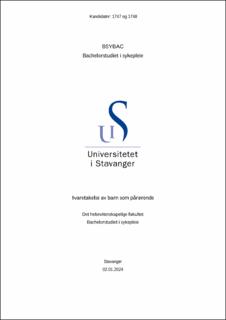| dc.contributor.advisor | Huseberg-Bru, Vendela | |
| dc.contributor.author | Bjaanes, Annette | |
| dc.contributor.author | Ege, Hannah Sande | |
| dc.date.accessioned | 2024-02-14T16:52:23Z | |
| dc.date.available | 2024-02-14T16:52:23Z | |
| dc.date.issued | 2024 | |
| dc.identifier | no.uis:inspera:185936777:66017081 | |
| dc.identifier.uri | https://hdl.handle.net/11250/3117719 | |
| dc.description.abstract | Bakgrunn: Når alvorlig sykdom rammer en familie, havner barn i en sårbar situasjon. Det gjør at barn blir pårørende, som kan ha en negativ innvirkning på barnets daglige liv, sosiale relasjoner og deres generelle utvikling. I slike situasjoner er det derfor avgjørende at barn blir ivaretatt og møtt med innsikt og forståelse av voksne, helsepersonell eller av et hjelpeapparat.
Problemstilling: Hvordan blir barn ivaretatt av helsepersonell når et familiemedlem er kritisk sykt?
Metode: Gjennom systematisk litteratursøk har det blitt anvendt fire kvalitative studier. Studiene er foretatt i Norge og Sverige, og baseres på to ulike perspektiv, fra perspektivet til barn som pårørende og fra perspektivet til sykepleierne. Dataene har videre blitt analysert etter Fribergs femtrinns analysemodell.
Resultat: Hovedfunnene deles inn i fire kategorier; omsorg fra sykepleierne og relasjons-bygging med barn, økt kompetanse for å ivareta barn, sykepleierens behov for informasjon og veiledning og barnas behov for støtte. Disse peker på hvilke tiltak som er nødvendig for å ivareta barn som pårørende.
Konklusjon: Studien indikerer et behov for systematiske endringer gjennom implementering av retningslinjer, internundervisning i sykepleieutdanningen og i avdelingene. Dette må gjøres for å optimalisere praksis og styrke sykepleiernes evne til å ivareta barn som pårørende.
Nøkkelord: Barn, pårørende, familie, omsorgspersoner, sykepleie, kritisk sykdom | |
| dc.description.abstract | Background: When serious illness strikes a family, children end up in a vulnerable situation. This means that children become next of kin, which can have a negative impact on the child's daily life, social relationships and their general development. In such situations, it is therefore crucial that children are looked after and met with insight and understanding by adults, health personnel or by an assistive personnel.
Problem: How are children cared for by healthcare personnel when a family member is critically ill?
Method: Through a systematic literature search, four qualitative studies have been used. The studies have been carried out in Norway and Sweden, and are based on two different perspectives, from the perspective of children as next of kin and from the perspective of the nurses. The data has also been analyzed according to Friberg's five-step analysis model.
Result: The main findings are divided into four categories; care from the nurses and relationship-building with children, increased competence to look after children, the nurse's need for information and guidance and the children's need for support. These indicate which measures are necessary to look after children as relatives.
Conclusion: The study indicates a need for systematic changes through the implementation of guidelines, internal teaching in nursing education and in the departments. This must be done to optimize practice and strengthen nurses' ability to look after children as next of.
Keywords: Children, relatives, family, caregivers, nursing care, critical illness | |
| dc.language | nob | |
| dc.publisher | uis | |
| dc.title | Ivaretakelse av barn som pårørende | |
| dc.type | Bachelor thesis | |
